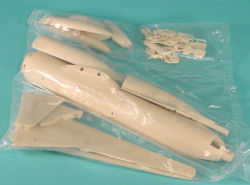
Nostalgic Plastic 1/144 C-133A/B Cargomaster Kit First Look
By Fotios Rouch
Images by Michael Benolkin
| Date of Review | August 2007 | Manufacturer | Nostalgic Plastic |
|---|---|---|---|
| Subject | C-133A/B Cargomaster | Scale | 1/144 |
| Kit Number | 44001 | Primary Media | Resin |
| Pros | Nice looking model of C-133 that isn't vacuformed! | Cons | Propeller parts are small and fragile, should have been cast as complete assemblies in this scale |
| Skill Level | Intermediate | MSRP (USD) | Out of production |
First Look
 |
 |
 |
 |
 |
 |
Douglas developed the turboprop C-133 to fulfill USAF requirements for a large-capacity strategic transport aircraft. Douglas put the Cargomaster straight into production without building any prototypes first. The first C-133A made its maiden flight on April 23, 1956. A single C-133A and a C-133B were built and were kept at the Douglas Long Beach facility as "test articles." They had neither construction numbers nor USAF tail numbers.
Production started in 1956 and ended in 1961 with 32 C-133As and 18 C-133Bs built all together. MATS started flying the C-133A around the world in 1958. USAF also had the C-124 in its inventory but it was slower and less powerful and it could not carry long cargo because of its internal configuration. The C-133B had its rear cargo doors modified to make an opening large enough to transport ballistic missiles such as the Atlas, Titan and other ICBMs as well as Saturn and Titan rockets to Cape Canaveral for use in the space program.
The C-133 established two trans-Atlantic speed records on flights to Europe as well as other weight lifting records. The Cargomaster though had its own share of problems. Severe vibration caused by the powerplants and the 18 ft propellers had caused critical stress corrosion on the airframe and the aircraft became not economical to operate beyond 19,000 hours. Quite a few were lost to accidents. By 1971 all Cargomasters were withdrawn from service as the plane became obsolete with the introduction of the C-5 Galaxy. Yet the Cargomaster is not dead. A small number were sold to private entities and were used for heavy cargo duties usually around Alaska. There have been sightings of one (N199AB registration) flying as late as June 2004!
This aircraft has been neglected for too long. I am aware of the nice 1/72nd scale Gene Hooker vacform kit and the subsequent atrocious Combat Models knock-off as well as the very nice 1/144th scale Welsh models vacform kits. After Anigrand came out with the C-124 and C-17 resin kits in 1/72nd scale many of us started hoping that maybe there was a chance for a resin C-133 to come and find its place in our collections. Well, that did not quite happen like that and instead we got the very first kit under the Nostalgic Plastic logo which is manufactured by Anigrand Craftswork.
The first Nostalgic Plastic kit is of the C-133A/B and it comes in 1/144th scale. Even so, the assembled fuselage is still about 12 inches long. This is a full resin kit with clear resin windscreen, decals and an informational CD with walk around. No metal parts are provided.
The fuselage comes in four pieces just like Anigrand’s C-124 kit. The front fuselage plug contains the cockpit cavity and a basic cockpit which is very adequate for this scale. Similarly there is a lower cavity provided with the front fuselage that houses the front landing gear. The landing gear, front and main is provided in resin and I hope it is strong enough to support the model.
All the wings and tails are solid resin pieces with cast locating pins that should help locate the parts and match them to the receiving holes in the fuselage.
There are four engine nacelles provided that appear to fit pretty good to the wings. The propellers are going to need patience and care to assemble as the come in four parts with a separate prop hub and prop blades. Maybe an assembly jig will have to be constructed to be able to build all the props to look the same.
The landing gear sponsons come as separate parts and care will need to be exercised to get them to fit snugly to the fuselage. The advantage of this approach is that a wheel well is generated this way for a more realistic look.
In this kit the canopy glazing is provided in clear resin and it looks reasonably clean and probably very adequate for the scale after it is dipped in Future.
The surface scribing in this kit is fairly light and consistent. The fuselage windows are depicted as light depressions and the reinforcement ribs are also present on the front portion of the fuselage as scribed lines.
The instructions also provide templates on how to fill panel lines and scribe new ones for the rear cargo bay as it was different for the C-133A and C-133B.
The decal instructions are showing five different C-133s (three As and two Bs) that can be chosen from for this kit.
The decals look simple but very good and are in register.
I believe this is a good first effort by Nostalgic Plastic, especially starting with Anigrand's great capabilities. Some things could have been done better. The propellers for example could have been done in white metal as complete units. The landing gear could have been done in metal as well just like in the Welsh C-133.
This kit is recommended to modelers with some experience in resin kits.
My sincere thanks to Nostalgic Plastic for this review sample!







